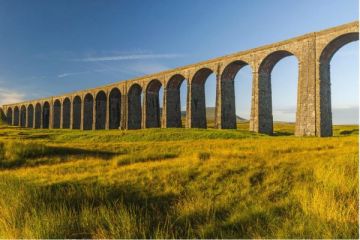This absurdly long article describes a lovely walk my wife and I took on a sunny spring day when we decided to explore the historic sites (and sights) of Winchester, Hampshire. I say 'we' in the broadest possible sense; it was really me wanting to take advantage of a rare bit of sunshine to see this wonderful city again. I'd been to Winchester years ago, long before decent digital cameras appeared, and I'd come away with a truly dreadful collection of photos. This time, weather permitting, I was determined to get some really great photos of the best that historic Winchester has to offer.
We set off from our home in Gloucestershire around 7 am and arrived in Winchester about 8:30. Having done my research diligently we decided that the Chesil multi-story car park, just to the east of the River Itchen, was ideally located for our purposes. There are numerous other car parks in Winchester, but the Chesil was relatively cheap for all-day Saturday parking and within easy walking distance of the city centre. And, as it turned out, the car park was almost totally deserted on a Saturday morning. Good choice!
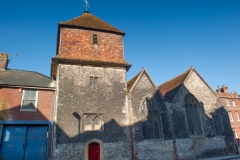
St Peter Cheesehill
We left the car park, exited onto Chesil Street, and almost instantly were confronted with the first historic site on my list; St Peter's Church. This medieval church (sometimes known as St Peters Cheesehill) was built sometime before 1142 when the Priory of St Denis claimed the 'chapel of St Peter outside Eastgate'.
The orientation and layout of the church suggest that it acted as a boundary of the Chesil suburb and possibly served a defensive purpose. The most impressive feature is the tower, topped with a pyramidal tile roof that was probably hung in the 18th century. The church stopped being used for worship following World War II, and by the 1960s it was in a serious state of disrepair.
The building was threatened with destruction when Chesil Street was widened, but it was saved by the Winchester Preservation Trust - the first project undertaken by the Trust. The Winchester Dramatic Society undertook to keep the church repaired in exchange for rent-free use of the building; the interior is used as a theatre, with the nave acting as a stage, the vestry as a dressing room, and the tower as a wardrobe.
A note on names: Chesil Street has nothing to do with Chesil Beach, in Dorset. It also has nothing to do with cheese, though the name is popularly mangled as Cheesehill. It comes instead from the old Saxon ceosel, meaning gravel.
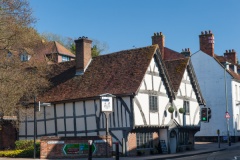
Old Chesil Rectory
Not surprisingly the church wasn't open at this hour of the morning so we turned right and headed up Chesil Street towards the junction with Bridge Street. There on the corner is one of the most photogenic timber-framed buildings in Winchester; the Old Chesil Rectory.
Now a popular restaurant, the Rectory has a sign outside the low door proudly boasting that it was built in 1450. A survey by the City of Winchester casts some doubt on this date, and suggests the house probably dates to the early 16th century. No matter; its so blessed pretty a few years won't bother a passionate medievalist like me!
The Rectory was originally a private dwelling and only became the rectory house for St Peter Cheesehill after the Reformation. Around 1760 the house was divided in two to create a pair of tenements, but the division was removed in 1890. The building stands three storeys high, with beautiful half-timbers infilled with plaster on the upper two storeys, while the ground storey is mainly brick.
The upper floors project out over the ground floor in traditional late-medieval style, and the gable ends are decorated with attractively carved barge boards. The building, sometimes popularly known as Cheese House, was the site of Winchester's first Sunday school.
Leaving the Rectory behind, we crossed over Chesil Street and headed west along Bridge Street, over the River Itchen. Across the bridge is the National Trust's City Mill, a restored 18th-century corn mill. More on the mill later, as we'll be coming back this way (besides, it wasn't open yet!).
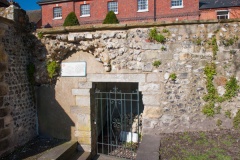
Roman Wall
We could see the famous statue of King Alfred on Broadway, lit by the morning sun, but we turned left along the river at the east end of the bridge and followed the signed footpaths along the line of the old city walls. This area is extremely pretty, with wide paved paths leading beside the river.
After a few minutes we came to a set of attractive brick almshouses, dedicated to St Mary Magdalen. Though they at first glance appear old, the almshouses actually date to 1929, but they were built to replace medieval almshouses which were pulled down in 1788.
To the right of the almshouse steps is a much more ancient reminder of Winchester's past; a small opening in the stone wall shows remains of the original Roman town walls. The wall was erected in the 3rd century AD and enclosed an area of roughly 144 acres. Sadly there are few reminders of Winchester's Roman heritage remaining on public view beyond this short fragment of wall.
We carried on along the footpath, following the River Itchen, with the medieval boundary wall of Wolvesey Castle on the right. The wall curves after a few hundred yards and we found ourselves on College Street. Ahead, over a high brick wall, a gleaming white stone church tower caught our eyes.
No, not the cathedral, it was the tower of Winchester College chapel. We ignored the college temporarily and followed the wall on our right to an information plaque for Wolvesey Castle. The castle was the medieval home of the powerful Bishops of Winchester until they built the 'new' Bishops Palace in the 17th century.
You can easily see the Bishop's Palace through the iron gates, but the path to the castle was locked (still too blessed early!), so we passed up College Street to the entrance gates to Winchester College.
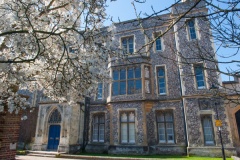
Winchester College
The College was founded by Bishop William Wykeham in 1382. Wykeham served as advisor to King Richard II, and was one of the most powerful men in late 14th century England. The school was intended to provide students for New College, Oxford University, also founded by Wykeham. Over the centuries it became one of the most prestigious and exclusive public schools in England.
Now, I had carefully checked the College website and discovered to my delight that there were guided tours scheduled throughout the day, so it was a major disappointment to see a signboard outside the college gates informing visitors that all tours were cancelled that day. Drat! Well, at least I have an excuse to come back again on another day.
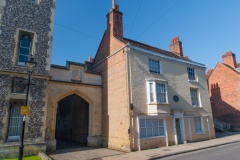
Jane Austen House
Immediately west of the College at 8 College Street is a simple cream-coloured house with an unobtrusive plaque above the door. This is 'Jane Austen House', where the novelist lived immediately before her death. She lived at nearby Chawton, and only came to Winchester with her beloved sister Cassandra to seek medical care.
Austen did not write any of her famous novels here; by the time she came to Winchester she was in very poor health, and she died on 18 July, 1817 and was buried in the Cathedral. The house is not open to the public, but for many Jane Austen fans this secluded little house is an essential stop on their 'Austen pilgrimage'!
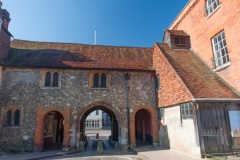
upon Kingsgate
St Swithuns upon Kingsgate
We followed College Street as it curved right and found ourselves at Kingsgate, one of two surviving medieval city gates. Kingsgate is popular for two features; on the right as you pass beneath the arched opening is a small bookshop built right into the gateway.
Pass through the arch and look left; there is a stair that takes you up to St Swithuns upon Kingsgate, a tiny medieval church built over the gateway arch. The church may have originally served as a chapel for workmen labouring on the cathedral.
Today, it is one of Winchester's hidden treasures. There are fragments of medieval glass in the east window and several interesting memorials on the walls. Look for an unusual piscina built into a window ledge on the north wall.
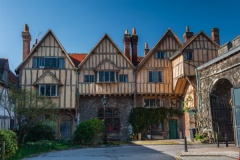
Cheyney Court
Leaving the church we turned right and passed through Priory Gate into the Cathedral Close. Look up above Priory Gate and you'll see a miniscule Porter's Lodge, once used as a house by the cathedral organist. Immediately inside the gateway arch is Cheyney Court, one of the most photographed buildings in Winchester.
This attractive timber-framed building dates to the 16th century and served as a venue for the Bishop's court for the Soke of Winchester until 1835. On the north side is a 16th-century stable block.
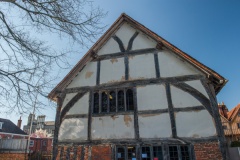
Pilgrim's Hall
At right angles to Cheyney Court is an even older timber-framed building. This is Pilgrim's Hall, built around 1290 for pilgrims to the shrine of St Swithun in the cathedral. The pride of Pilgrim's Hall is an ancient hammer-beam roof, thought to be the oldest surviving such roof in England. To the north of the Hall is Pilgrim's School, established in the medieval period, but housed in 17th and 18th century buildings.
Straight ahead we went, into the heart of the cathedral close. There are numerous historic buildings within the close, but none are regularly open to visitors. Straight ahead is The Deanery, a beautiful medieval building dating to the 14th century. Within the Deanery is a late 17th-century library formed from the medieval long gallery.
Beside the Deanery, accessed through a 13th-century gateway, is Dean Garnier's Garden, a quiet walled garden that looks onto the north face of the cathedral. This gets my vote as the most beautiful secluded green space in Winchester!
The garden stands on the site of the monks dormitory of St Swithun's Priory, and overlooks the ruins of the priory chapter house. The garden (actually three distinct garden areas joined together) commemorates Thomas Garnier, Dean of Winchester from 1840–1872.
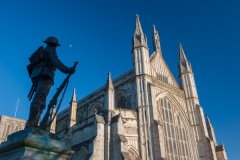
Winchester Cathedral
From the garden, we made our way around to the west front of the cathedral, which was now open. For the next few hours we explored the cathedral interior. I won't cover everything we saw - you can read all about the cathedral in our main article, but suffice it to say there was plenty to see.
Though I'd visited several times before, it struck me again what a magnificent building this is. The thing I enjoyed most were the extraordinary chantry chapels. These 'mini-churches' were built by and for important nobles and churchmen. Each chantry would have had at least one priest charged with saying prayers for the donor's soul in perpetuity.
Another highlight for me was the Triforium Gallery, where bits of St Swithun's medieval shrine have been put on display, along with several Saxon treasures associated with the cathedral. One piece in particular caught my eye; a glass bowl thought to be the earliest example of Saxon glasswork still in existence.
We finally dragged ourselves away from the cathedral and discovered it was noon, and we decided it was time for a spot of lunch. We nipped into the cathedral restaurant opposite the main west doors, where aside from food we found a memorial to William Walker, a deep-sea diver who famously spent over a decade diving underneath the cathedral to shore up the structure from collapsing under its own weight.
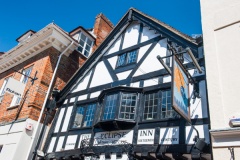
Eclipse Inn
From the cathedral, we made our way to Market Lane and turned left, following the street to where it becomes The Square. On the right (north) side of the street is the Eclipse Tavern, an attractive timber-framed building dating to the 16th century.
This is one of the oldest inns in the city - and one of the prettiest. The Eclipse was originally a rectory for St Lawrence church, now half hidden amid the shops that line the passage between The Square and High Street.
Opposite the Eclipse is a stone building on the site of the Old Market House. A plaque on the side of the building reminds us of one of Winchester's most dramatic and tragic moments.
It was here in 1685 that Lady Alice Lisle was executed for treason, accused of harbouring supporters of the Duke of Monmouth after the Battle of Sedgmoor.
Lisle, an elderly woman whose only offence seems to have been a desire to act charitably towards those in trouble, was tried by the infamous Judge George Jeffreys, and her trial kicked off what became known as The Bloody Assizes, which probably did more to turn people against James II than any other royal act. Now busy shoppers bustle past the site of Lady Lisle's execution in the centre of the street.
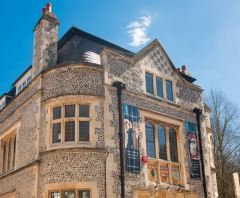
City Museum
At the end of The Square stands Winchester City Museum, which hosts exhibits on the city's history. My wife and I decided to split up (a note to our kids - that's merely an expression; we'e not actually splitting up). She explored the museum while I went in search of the entrance to St Lawrence Church.
It is so easy to miss! If you follow the pedestrian passage towards the High Street you'll find the church door tucked away on your right. The church brochure proudly states that St Lawrence's is the only Norman church within the old city walls still in use. And it certainly was in use, for on entering I discovered the vicar and organist getting ready for a wedding. Drat!
I had time for a few quick photos and a look around the light-filled nave before I figured I should beat a dignified retreat and not get in the way of flower arranging.
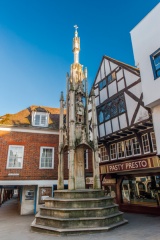
Buttercross
From St Lawrence, we went up the passage to the High Street. To the right is the Buttercross, a marvellous early 15th century pinnacled market Cross in Perpendicular style. The cross is also known as City Cross, or simply High Cross, and was used as a focal point for a farmer's market.
It is now a Scheduled Ancient Monument, but the authorities were not always so keen to preserve it as they are now; in 1770 the Paving Commissioners sold it to into private hands. When the new owner tried to remove his property the citizens of Winchester rose up in arms, and prevented the cross from being taken away.
The cross is adorned with a dozen figures, the four at lower level representing people associated with Winchester, including Alfred the Great, William of Wykeham, Lawrence de Anne (a medieval mayor of the city) and St Amphibalus, an early 4th-century Christian martyr who is said to have had a post-Roman church dedicated to him in Winchester.
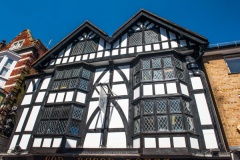
Godbegot House
From the Buttercross we proceeded west (literally 'up' the High Street), heading for the Castle at the top of the street. On the way we passed quite a few fascinating historic buildings and local landmarks.
One of the first was Godbegot House, on the north side of the street. This beautiful timber-framed building, now a shop, has nothing to do with either God or 'begetting'. Instead, the name is a mangling of Godbegeaton, which translates loosely as 'good bargain'. This area was a part of Winchester's main market area as early as the 11th century.
The current Godbegot House dates to the middle of the 15th century. It was just one of several joined houses built by the Cathedral and let out to tenants.
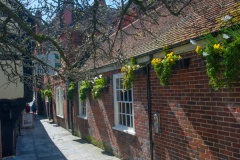
Royal Oak Inn
Beside Godbegot House a narrow lane leads to the Royal Oak, a red-brick inn with a sign proudly proclaiming it to be the oldest inn in England. That claim to fame rests on a royal charter of 1002, when King Ethelred the Unready granted an estate here to his wife Emma as a wedding gift. Emma's estate included several dwelling houses as well as Godbegot House.
Emma's son Edward, later known as 'The Confessor' spent part of his childhood in his mother's tenement here. Royalist supporters frequented the inn during Cromwell's Commonwealth, and the inn gained its prefix 'Royal' after the Restoration of Charles II to the throne after Cromwell's death. The Royal Oak is built over an ancient hollow-way, a sunken track worn by travellers. The cellars contain stonework that may pre-date the Norman Conquest.
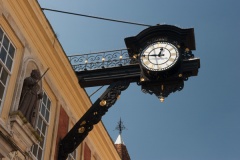
Town Clock
On the other side of High Street is one of the town's most enduring symbols, a clock presented after a visit from Queen Anne in 1713. The clock is attached to a building which once served as the city Guildhall, or seat of local government. That role is now filled by a much larger and grander Victorian building at the bottom of High Street.
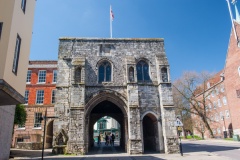
Westgate
Well, with all these distractions out of the way we finally arrived at the top of High Street. There we nipped into the Westgate Museum. Westgate is one of only 2 surviving city gates, the other being Kingsgate. The upper floor contains a small museum with displays on Tudor and Stuart Winchester.
You can dress up in Tudor clothes, try your hand at brass rubbing, and climb the narrow stairs to the roof for a look over the rooftops of Winchester. I tried on a Civil War helmet (blinkin' heavy!) and took a photo of my wife in a Tudor headdress, then it was off to the castle, a few paces south of the Westgate.
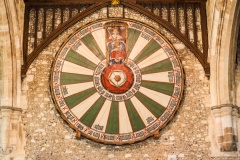
King Arthur's Round Table
Winchester Castle
One of the first castles built by the Normans after the Battle of Hastings, and certainly one of the most important Norman fortresses, Winchester Castle was the seat of government before power was transferred to London.
There is very little of the once powerful castle remaining save scanty foundations and the restored 14th-century Great Hall built by Henry III. The hall was the social centre of the castle, a place where people ate, slept, and transacted business. The interior is almost bare save for a huge statue of Queen Victoria seated in regal splendour, and another of Winchester's most popular symbols, a huge round table set high upon the end wall.
This table, now painted with Tudor symbols, is the legendary Round Table of King Arthur (well, at least, that's the story). In fact it dates to the 13th century. Behind the great hall is Queen Eleanor's Garden, a faithful recreation of a 14th century garden such as Queen Eleanor of Castile, wife of Edward I, or Queen Eleanor of Provence, wife of Henry III, might have enjoyed on their visits to Winchester.
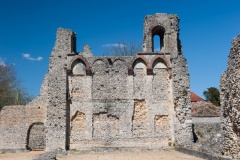
Wolvesey Castle
From the Castle, it is only a short walk to the Military Museums, but looking at the swiftly advancing clock we decided to head for Wolvesey Castle. We retraced our steps back down High Street, cut through the cathedral close and Kingsgate, and found ourselves back at the Bishop's Palace on College Street.
The gate to the castle was open so we followed the path to the castle grounds. The castle was used by the Bishops of Winchester as their principal residence from around 1100. Various bishops left their mark on the castle, but the most influential was Henry of Blois, bishop during the Civil War between Stephen and Maud.
Though the castle ruins were fascinating (I like crumbling old bits of stone!) one of the most memorable parts of the castle was one of Bishop Henry's innovations; a complete water and sewage system, with running water and settling tanks. The good bishop was a man well ahead of his time.
From the entrance to the castle, we walked down College Walk, with the College wall to our right. The road curves around to a dead end, but from there a signed footpath leads south beside the water meadows of the River Itchen towards St Cross. We were headed for St Cross Hospital, a 12th century set of almshouses established by Bishop Henry of Blois, arguably the oldest charitable establishment in England.
The walk was a delight, leading through attractive meadows, with the playing fields of Winchester College to our right for the first part of the journey. If you look left across the meadows you will see a large hill across the river.
This is St Catherine's Hill, a popular walk for locals and visitors alike. If you look closely you can make out the shape of earthworks near the crown of the hill, a sign of the Iron Age hillfort that was established here over 2000 years ago. I toyed with the idea of following a signed path from Garnier Road towards St Catherine's Hill but decided we didn't have time. Next trip.
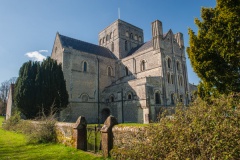
St Cross Hospital
We arrived after a lovely stroll of perhaps 20 minutes at the high stone walls of St Cross Hospital. There are two main parts to the Hospital; the almshouses and associated common areas, and the exquisite Norman church, begun as a chapel for residents of the almshouses.
With impeccable timing we'd arrived while a wedding was going on at the church, so we explored the very attractive Dean's gardens, craned our necks to take in all the carvings embellishing the gatehouse (itis huge!) and finally poked our noses into the hall.
This deliciously complete medieval chamber has a minstrel's gallery at the west end, with tables for brethren arranged around a central hearth. There are several other small chambers beyond the hall, including a kitchen and cellars.
By the time we emerged into the sunlight the wedding was over so we nipped into the church. Simon Jenkins, with whom I don't always agree, calls this wonderful Norman building a cathedral in miniature. He's right. St Cross is one of the most appealing Norman church I have ever explored, and the vaulting is simply superb.
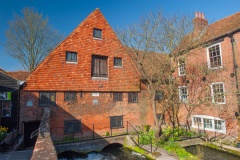
City Mill
Sighing with contentment (I'm like that when I visit historic churches), we headed back along the river towards Winchester. We arrived back at the Bishops Palace, but this time we kept following the river, with the Wolvesey Castle wall on our left and the river on our right. We were headed for City Mill, which would only be open for another half hour.
There has been a mill here on the Itchen since Saxon times, when Queen Elfrida granted a mill to Wherwell Abbey. The mill passed to the crown at the Dissolution of the Monasteries, and was granted by Queen Mary to the City of Winchster to help defray the cost of her marriage here to Philip of Spain. The current building dates to 1743, though it incorporates bits of the medieval structure.
We split up again and my wife crossed Bridge Street to the Mill, while I carried on across the bridge and turned left up St John's Street, climbing the hill to another of Winchester's hidden treasures, the historic 12th-century church of St John's in the Soke.
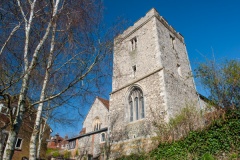
St Johns
The Soke lies outside the medieval city boundary, an area traditionally administered directly by the Bishop, not by the city. The church of St John dates to 1193, with a 15th century tower, and stands on the line of an old drover's road which itself follows a Roman road and the route taken by pilgrims to Canterbury.
The first students of Winchester College attended church here while the college was being built. Within the light-filled church is a 15th-century rood screen and several late 13th-century wall paintings.
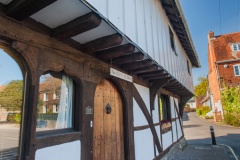
Old Blue Boar
It usually takes me ages to explore a church, and this time was no exception. By the time I'd finished my wife had joined me and we walked up St John's Street to the lovely timber-framed house on the corner.
This is the Old Blue Boar Inn, a strikingly pretty 14th-century house that is one of the oldest dwellings in Winchester, and a very good example of a traditional hall house with a projecting gallery. Despite the name, it is no longer an inn, but a private house, and not open to the public (I wonder if owners of medieval houses get used to tourists photographing their homes?).
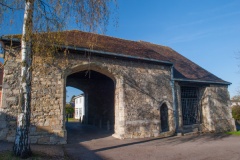
Hyde Abbey Garden and Gatehouse
From this point, we could have gone through Joyce's Garden and Magdalen Hill to St Giles Hill viewpoint, a route that the City of Winchester promotes as a Sunset Walk. Well, seeing as the setting sun would have been shining straight into my face I didn't fancy that route, so we headed down Blue Boar Hill (street signs have it as Blue Ball Hill) to Water Lane, turned right up Water Lane, and crossed the River Itchen at Derngate Bridge.
This took us to North Walls, which, as the name suggests, runs along the line of the medieval city walls. We turned right up Park Avenue, past the School of Art with its modernistic architecture, then left at the end of the street, past the Leisure Centre. Near the parking area, we cut across to the end of King Alfred Place, where a memorial made of turf, concrete, and gravel marks the outline of the monastic church of Hyde Abbey.
The abbey was established in 1110 and possessed one of the most impressive Romanesque churches in the country. There are three large concrete rectangles on the gravel, marking the site where Alfred the Great, his wife Ealhswith, and their son Edward the Elder were buried.
We walked up King Alfred Place to Hyde Abbey Gatehouse, (almost) the last part of the abbey still standing. The gatehouse was the main public entrance into the abbey compound and later served as the entry gate to Hyde House, an opulent Tudor house, now vanished. If you walk through the gate and follow the path to the left you will see a turf-covered bridge, one of the last vestiges of the original abbey buildings.
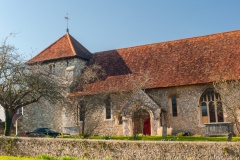
Hyde
St Bartholomew's Church
Directly across the road from the gatehouse is St Bartholomew's Church. This lovely 11th-century church features a 13th-century doorway and tympanum. Inside the church are column capitals rescued from Hyde Abbey at the Dissolution. St Bartholomew's has been in the news recently after an ancient tomb was dug up which historians are hoping might be the grave of King Alfred the Great.
At this point, we got lost. I won't bore you with the details, but what we should have done was go to the end of King Alfred Street and turn left down Hyde Street and make our way back to North Walls. We eventually ended up there so that's where I'll pick up the story.
We crossed North Walls onto Jewry Street, followed that all the way to the end, turned right onto High Street then immediately left onto Southgate Street, following the signs for Winchester's Military Museums.
I knew the museums would be closed, as it was well past 6 pm, but the evening was lovely and I had a desire to see the Peninsula Barracks, which houses five distinct military museums. Behind the Hotel du Vin a footpath leads up behind Serle's House and the Royal Hampshire Regimental Museum. From there a winding path leads steeply uphill to the main square of the barracks complex.
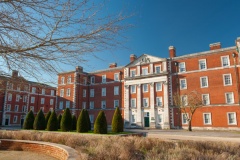
Military Museums
To understand the Peninsula Barracks you have to go back to 1683, when Charles II decided he wanted a grand new royal palace in Winchester, in the style of Versailles. He called in Sir Christopher Wren to design his new palace, but Charles died in 1685 and his successor James II cancelled the plan after only a part of the palace had been built. The 17th century King's House, as it was known, was used as a military prison and as the focus for a complex of military barracks until it eventually burned down in 1894.
The house and barracks were completely rebuilt in the early 20th century, keeping the stately elegance of the earlier buildings. Today the barracks are used as private apartments but also to house five independent museums to military regiments associated with Hampshire. These include the Ghurkas, Green Rifles, Royal Hussars, General Corps, and Royal Hampshire Regiment.
We relaxed in the Peninsula Square by a quiet fountain and drank in the gorgeous Queen Anne style buildings. I'm not a big fan of military architecture, but I thought the Peninsula Barracks were a wonderful recreation of historic buildings. After gathering our energy we turned right at King's House and followed the road past the Green Rifles museum to the main Military Museums entrance on Romsey Road.
We turned right and followed Romsey Road, which turned into High Street, coming upon Westgate again from the west. I wonder how many weary travellers welcomed the site of Westgate over the centuries, marking as it did the main west entrance to the city? Look up as you pass under the gateway arch and you'll see several amusing grotesque carvings.
We followed High Street past the Buttercross, now deserted, and found ourselves walking under the covered walkway of The Pentice. These attractive timber-framed buildings were used for minting coins and later as The Drapery, focal point of the city's important wool trade.
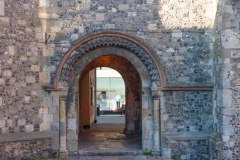
St Maurice's tower
St Maurice's Tower
Beyond Pentice is a passageway on the right that leads to the half-hidden tower of St Maurice's church. You really can't see the tower at all from High Street, but when you pass under the arch and look back, you realise you've come through a beautifully carved Norman doorway. St Maurice's was one of the most important churches in medieval Winchester.
It may have been a gateway chapel leading into the New Minster precinct (loosely equivalent to the current cathedral green and close). The church was pulled down in 1842 but the tower and Norman doorway were retained, along with several ancient grave slabs embedded in the pavement at the base of the tower.
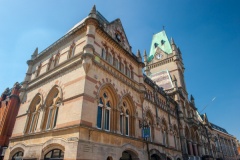
The Guildhall
We passed back under the church arch onto High Street again, and turned right, down the street, which turned into Broadway. We left the pedestrianised area and came to the imposing bulk of the Guildhall on the right (south) side of the street. The Guildhall is one of Winchester's most distinctive buildings; frankly, it is huge!
The original city guildhall was beside the Buttercross, in a small chamber over the passage that leads to the cathedral. By the early 18th century it moved further up High Street (where the Town Clock is now), but in 1871 an imposing new building was designed by Jeffrey and Skiller of Hastings, in grand Gothic Revival style.
The new Guildhall cost 16,000 pounds and was part of a complex serving as a courthouse, fire station, police headquarters, and a civic venue. Look up at the imposing clock tower and you can see a carving of the first Mayor of Winchester, Florence de Lune, receiving the city's charter from Henry II. The Guildhall now houses the local tourist information and art gallery, as well as exhibition and conference spaces.
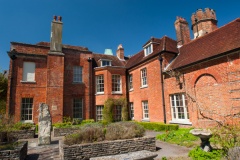
Abbey House and Garden
Immediately east of the Guildhall, on the same side of the road, is Abbey House, an attractive 17th-century house that serves as the official residence of the Mayor of Winchester. Abbey House stands on the site of Nunnaminster, a monastery founded around AD 900 by Ealhswith, Alfred the Great's queen, on land given to her by Alfred to mark his coronation in AD 871.
The monastery here was dissolved by Henry VIII and the property was sold. By 1700 John Pescod, the Recorder of Winchester, had erected a grand residence in red brick, surrounded by peaceful gardens. In 1889 the City Councillor bought the house and garden, refurbished the house as a mayoral residence, and opened the gardens to the public.
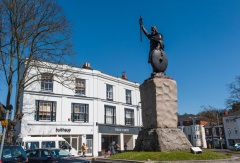
Alfred the Great Statue
Directly in front of Abbey House, on a traffic island in the middle of Broadway, stands the statue of Alfred the Great, holding his sword aloft (point down), and looking terribly stern. The statue stands near the old East gate entrance to the city and was sculpted by Hamo Thornycroft in 1899 to mark 1,000 years from Alfred's death. (it was actually erected two years later in 1901).
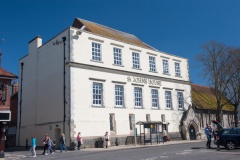
St John's Hospital
We crossed the street under Alfred's gaze and investigated St John's Hospital and Chapel. The whitewashed Georgian facade of the house (the large sign over the door proclaims it to be St John's House) hides ancient underpinning; an almshouse was founded here in AD 935 by St Brinstan, making St John's Hospital arguably the oldest charity in the country.
The kitchen vaults may have been part of the original Saxon almshouse. In 1289 it was refounded by John le Devenish and it still provides charity for the needy. Beside the main house is a small medieval chapel, established in 1400 by a descendent of Le Devenish, another John Devenish. Through a wrought-iron gate beside the chapel, you can see a small row of red-brick almshouses, built in 1856. There are further almshouses across Broadway on the south side of the street.
That's where we headed next, our weary feet wending their way back towards the river and the lure of our parked car.
But we had one more stop to make, to top off a perfect day of touring Winchester. We popped into the Bishop on the Bridge pub, on the west bank of the Itchen, almost opposite City Mill, for a cold pint. We carried our drinks out to the patio overlooking the river and sat back with a sigh while we watched the sun go down.
Now, I don't for a moment suggest you recreate our entire walk step for step; it was a long, long day, with lots of walking. But hopefully, you can choose the bits of our walk that appeal to you most and cobble together your own city walk of historic Winchester. There's just so much to see that you could putter along for days and see something new and interesting (or, in my case, something 'old' and interesting) every day.
